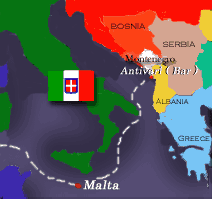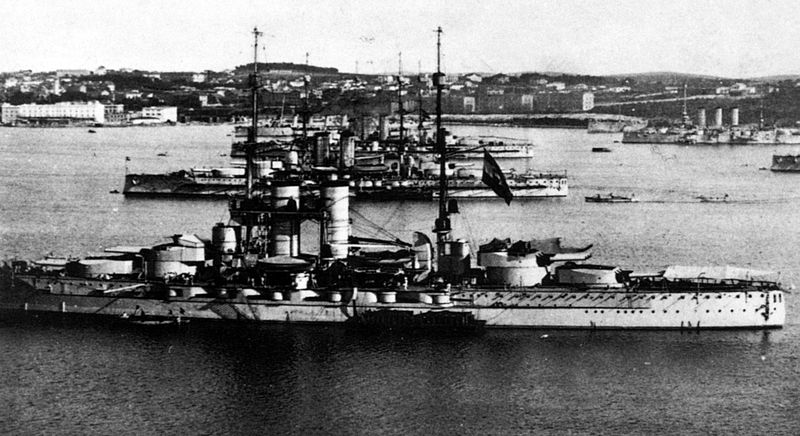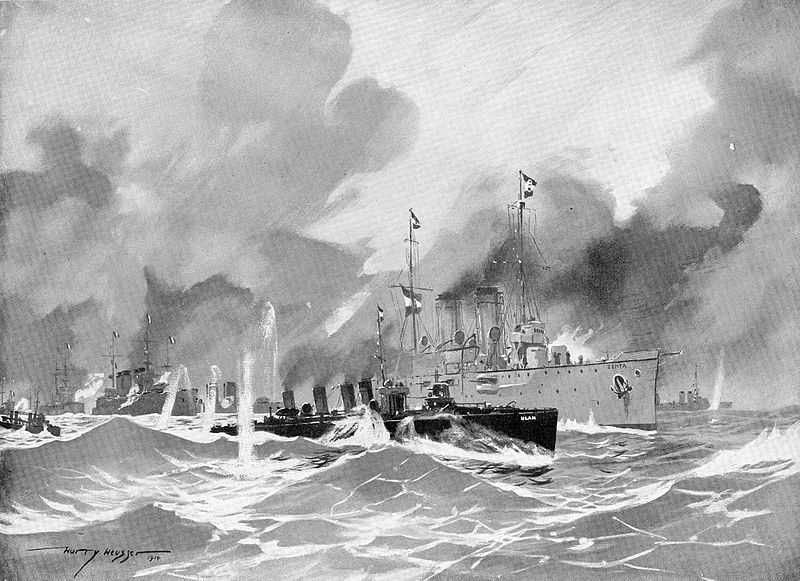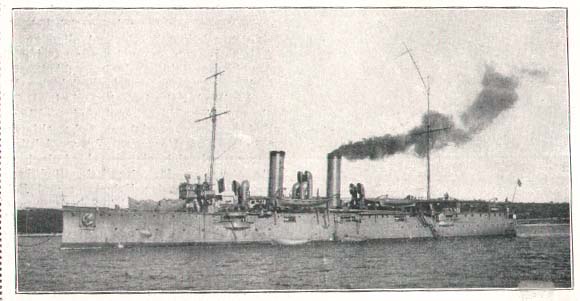 A visual of the area and route taken by the Allied ships. Although this engagement was all but fair (a recent dreadnought against an old cruiser) the ultimate result was almost a year round of inactivity for the Austro-Hungarian Navy (K.u.K Kriegsmarine) in the Adriatic
A visual of the area and route taken by the Allied ships. Although this engagement was all but fair (a recent dreadnought against an old cruiser) the ultimate result was almost a year round of inactivity for the Austro-Hungarian Navy (K.u.K Kriegsmarine) in the Adriatic
The Austro-Hungarians at war
The war broke out because of the Balkans, the assassination of Archduke Franz-Ferdinand was followed by a rejected inquiry by Austro-Hungarian authorities to Serbia, followed by a rejected ultimatum and war. By the alliances game, Serbia had the support of its natural ally Russia, which in turn could count on France. In response, Austria-Hungary was able to count on the German Empire for backup. But the first engagements of the Austro-Hungarian Army against Serbia, despite clear advantages, was nothing of a promenade. The Serbs managed to block and even repel the initial attacks with massive payback.
Situation in the Adriatic
On the naval front however it was expected from the K.u.K Kriegsmarine to take advantage of a clear cut superiority in the Adriatic. At that stage, the Austro-Hungarian Navy was not to be taken lightly with three brand new dreadnoughts (a fourth in achievement), 12 pre-dreadnought battleships, 13 cruisers, 27 destroyers and 79 torpedo-boats, as well as 7 submarines and many monitors and auxiliary ships of all sizes and tonnage. It was based mostly in Pola harbour and could easily defeat a very weak Montenegrin navy (perhaps a single gunboat, no info could be found) whereas the Serbian “navy” only counted a single patrol boat Jadar, based on the Danube in 1915. Since Italy was neutral, and perhaps then more inclined to join the central powers, Austro-Hungary has free hands in this “private lake” bordering the Balkans. In the Mediterranean however, this was another matter.

Austro-Hungarian Dreadnoughts and the fleet anchored at Pola. Despite real assets, from 1915, it was dwarfed by the combined might of the French, British and Italian navies and mostly condemned to inaction, trapped in the Adriatic.
At that time, since June 6, the proportion of the French fleet in the Mediterranean was such that the British thought fair to let the supreme naval command in the area to the French, the British naturally receiving supreme command of the Allied naval forces for the north sea. Thus, by treaty on June 6, the Royal Navy there was reduced to two armored cruisers (Defence and Warrior) and some light cruisers after by massive transfers to the North Sea,theoretically under the orders of Admiral Boué Lapeyrière. The latter, from the outset of the declaration of war, rallied Malta with the combined forces, then joined the Adriatic by executing an ostensible “naval review” in full strength and regalia to impress still undecided Italians.
The battle
On August, 14 the French fleet enters the Adriatic included 15 battleships (2 Courbet, 6 Danton and 5 Vérité), 6 armored cruisers (3 Léon Gambetta, Quinet, Renan, Michelet) and smaller cruisers. It was followed by British-armored cruisers from Gibraltar, the squadron of Admiral Troubridge. Alerted, the Austro-Hungarian fleet scrambled to rally in emergency the safe harbor of Pola. But Zenta had not been informed, and was still conducting operations of shelling of the small Antivari harbour.
She was safeguarded by destroyer Uhlan and 2 others. None did noticed the Courbet, a recently built dreadnought which opened fired at 20 000 m range. Soon 305 mm plumes squared the Zenta, which had no artillery capable of replicate at such distance. In very little time, the Zenta was severely hit, immobilized, and rendered all but helpless and burning. Her crew evacuated the soon-to-be hulk on rafts. The Destroyer Uhlan and two destroyers managed to flee thanks to their speed. The Zenta sank in a short time, but most of its crew safely joined the coast.

A painting of the battle of Antivari, by Harry Heusser, 1914.
Aftermath
This modest setback meant that the allies could now roam at will the Adriatic, blocking all the Austro-Hungarian initiatives. Initially at least, French presence dissuaded the naval forces stationed at Pola to start new coastal raids. But soon the allied forces departed and would be fully absorbed by operations in the Dardanelles. The Austro-Hungarian was then again free and ready for any action but only for a short time: Italy entered the war at about the same time. We will return on this chapter of the adriatic naval campaign soon. The “inaction” ended with a first major action Battle in Decemlber 1915, the battle of Durazzo, followed by by the Battle of the Strait of Otranto in 14-15 may 1917.

The Austro-Hungarian fleet

The cruiser Zenta in 1914.



 Latest Facebook Entry -
Latest Facebook Entry -  X(Tweeter) Naval Encyclopedia's deck archive
X(Tweeter) Naval Encyclopedia's deck archive Instagram (@navalencyc)
Instagram (@navalencyc)





 French Navy
French Navy Royal Navy
Royal Navy Russian Navy
Russian Navy Armada Espanola
Armada Espanola Austrian Navy
Austrian Navy K.u.K. Kriegsmarine
K.u.K. Kriegsmarine Dansk Marine
Dansk Marine Nautiko Hellenon
Nautiko Hellenon Koninklije Marine 1870
Koninklije Marine 1870 Marinha do Brasil
Marinha do Brasil Osmanlı Donanması
Osmanlı Donanması Marina Do Peru
Marina Do Peru Marinha do Portugal
Marinha do Portugal Regia Marina 1870
Regia Marina 1870 Nihhon Kaigun 1870
Nihhon Kaigun 1870 Preußische Marine 1870
Preußische Marine 1870 Russkiy Flot 1870
Russkiy Flot 1870 Svenska marinen
Svenska marinen Søværnet
Søværnet Union Navy
Union Navy Confederate Navy
Confederate Navy Armada de Argentina
Armada de Argentina Imperial Chinese Navy
Imperial Chinese Navy Marinha do Portugal
Marinha do Portugal Mexico
Mexico Kaiserliche Marine
Kaiserliche Marine 1898 US Navy
1898 US Navy Sovietskiy Flot
Sovietskiy Flot Royal Canadian Navy
Royal Canadian Navy Royal Australian Navy
Royal Australian Navy RNZN Fleet
RNZN Fleet Chinese Navy 1937
Chinese Navy 1937 Kriegsmarine
Kriegsmarine Chilean Navy
Chilean Navy Danish Navy
Danish Navy Finnish Navy
Finnish Navy Hellenic Navy
Hellenic Navy Polish Navy
Polish Navy Romanian Navy
Romanian Navy Turkish Navy
Turkish Navy Royal Yugoslav Navy
Royal Yugoslav Navy Royal Thai Navy
Royal Thai Navy Minor Navies
Minor Navies Albania
Albania Austria
Austria Belgium
Belgium Columbia
Columbia Costa Rica
Costa Rica Cuba
Cuba Czechoslovakia
Czechoslovakia Dominican Republic
Dominican Republic Haiti
Haiti Hungary
Hungary Honduras
Honduras Estonia
Estonia Iceland
Iceland Eire
Eire Equador
Equador Iran
Iran Iraq
Iraq Latvia
Latvia Liberia
Liberia Lithuania
Lithuania Mandchukuo
Mandchukuo Morocco
Morocco Nicaragua
Nicaragua Persia
Persia San Salvador
San Salvador Sarawak
Sarawak Uruguay
Uruguay Venezuela
Venezuela Zanzibar
Zanzibar Warsaw Pact Navies
Warsaw Pact Navies Bulgaria
Bulgaria Hungary
Hungary

 Bundesmarine
Bundesmarine Dutch Navy
Dutch Navy Hellenic Navy
Hellenic Navy Marina Militare
Marina Militare Yugoslav Navy
Yugoslav Navy Chinese Navy
Chinese Navy Indian Navy
Indian Navy Indonesian Navy
Indonesian Navy JMSDF
JMSDF North Korean Navy
North Korean Navy Pakistani Navy
Pakistani Navy Philippines Navy
Philippines Navy ROKN
ROKN Rep. of Singapore Navy
Rep. of Singapore Navy Taiwanese Navy
Taiwanese Navy IDF Navy
IDF Navy Saudi Navy
Saudi Navy Royal New Zealand Navy
Royal New Zealand Navy Egyptian Navy
Egyptian Navy South African Navy
South African Navy






























 Ukrainian Navy
Ukrainian Navy dbodesign
dbodesign